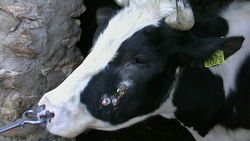Mandibular Osteomyelitis
| This article is still under construction. |
Description
Lumpy jaw is a chronic infectious condition which affects cattle. It is caused by the anaerobic filamentous bacteria Actinomyces bovis Actinomyces is a normal commensal of the oral cavity and upper respiratory tract of cattle, it gains entery to underlying soft tissue when the mucosa is damaged by trauma or eruption of teeth.
Signalment
The condition affects cattle 2-5 yrs old, those that are exposed to sharp objects whilst feeding and when the teeth are erupting. It is found worldwide but is most prevelent in Western and mid-western states of the USA.
Diagnosis
The condition is easily diagnosed on clinical signs and can be confirmed by crushing and staining the yellow granules expressed with the pus from skin leisions to reveal gram-positive filamentous rods.
Clinical signs
Pathology
Treatment
Treatment is difficult due to the nature of the leisions and poor antibiotic penetration.
Prognosis
Treatment is rarely successful and recurrence of leisions is common; slaughter is advised.
References
- Andrews, A.H, Blowey, R.W, Boyd, H and Eddy, R.G. (2004) Bovine Medicine (Second edition), Blackwell Publishing
- Merck & Co (2008) The Merck Veterinary Manual (Eighth Edition) Merial
Pathology
3 major features:
- Inflammatory removal of bone. As cortex of bone is pushed out by central inflammation produces thinning of bone cortex with proliferation of new periosteal bone. The centre of the mandible is eroded forming a honeycomb-like bone. Eventually will erode through bone producing granulomatous lesion on bottom of mandible and eventually eroding through skin.
- Granuloma with micro abscess's in centre with greenish / yellow granules in middle of pus. These granules known as "sulphur bodies". Sulphur body is a colony of tangled mass of Actinomyces filaments. This is surrounded by neutrophils and macrophages forming a pyogenic granuloma.
- Masses of fibrous tissue surround the granuloma and fill the spaces where bone has been destroyed.
| Also known as: | Lumpy jaw |
